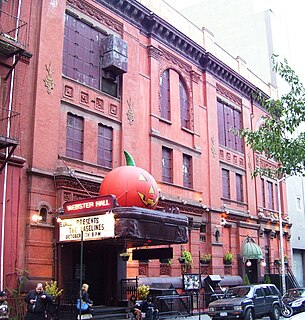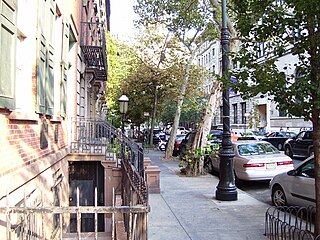
Brewster is a village within the town of Southeast in Putnam County, New York, United States. Its population was 2,390 at the 2010 census. The village, which is the most densely populated portion of the county, was named for two early farmer landowners, Walter and James Brewster.

The Jefferson Market Branch of the New York Public Library, once known as the Jefferson Market Courthouse, is a National Historic Landmark located at 425 Avenue of the Americas, on the southwest corner of West 10th Street, in Greenwich Village, Manhattan, New York City, on a triangular plot formed by Greenwich Avenue and West 10th Street. It was originally built as the Third Judicial District Courthouse from 1874 to 1877, and was designed by architect Frederick Clarke Withers of the firm of Vaux and Withers.

This is a list of the properties and districts listed on the National Register of Historic Places listings in Onondaga County, New York. The locations of National Register properties and districts may be seen in a map by clicking on "Map of all coordinates". There are 162 properties and districts listed on the National Register in the county. Of those, 54 are outside the city of Syracuse, and are listed here, while the rest are covered in National Register of Historic Places listings in Syracuse, New York. One property, the New York State Barge Canal, spans both the city and the remainder of the county.

Webster Hall is a nightclub and concert venue located at 125 East 11th Street, between Third and Fourth Avenues, near Astor Place, in the East Village of Manhattan, New York City. It is one of New York City's most historically significant theater and event halls, having hosted social events of all types since the club's construction in 1886 as a "hall for hire". Its current incarnation was opened in 1992 by the Ballinger brothers, with a capacity of 1,400, providing its traditional role as well as for corporate events, and for a recording studio.

The Morris–Butler House is a Second Empire-style house built about 1864 in the Old Northside Historic District of Indianapolis, Indiana. Restored as a museum home by Indiana Landmarks between 1964 and 1969, the American Civil War-era residence was the non-profit organization's first preservation project. Restoration work retained some of its original architectural features, and the home was furnished in Victorian and Post-Victorian styles. Its use was changed to a venue for Indiana Landmarks programs, special events, and private rentals following a refurbishment in 2013. Regular daily tours of the property have been discontinued.

The Merchant's House Museum, known formerly as the Old Merchant's House and as the Seabury Tredwell House, is the only nineteenth-century family home in New York City preserved intact — both inside and out. Built "on speculation" in 1832 by Joseph Brewster, a hatter by trade, it is located at 29 East Fourth Street, between Lafayette Street and the Bowery in Manhattan. It became a museum in 1936, founded by George Chapman, a cousin of the family who once lived there.

The Villard Houses is a historic landmark at 455 Madison Avenue between 50th and 51st Street in Manhattan, New York City. The building was constructed in 1884, designed by architect Joseph M. Wells of McKim, Mead and White in the Renaissance Revival style. It is listed on the National Register of Historic Places and is a New York City designated landmark.

The Cobblestone Historic District is located along state highway NY 104 in Childs, New York, United States. It comprises three buildings that exemplify the cobblestone architecture developed to a high degree in the regions of upstate New York near Lake Ontario and exported to other areas with settlers.

Lockerbie Square Historic District is a national historic district on the National Register of Historic Places within Indianapolis, Indiana, listed on February 23, 1973, with a boundary increase on July 28, 1987. It is noted for its Federal, Italianate, and Queen Anne style architecture. The original platting of Lockerbie Square, done by Jannett Smith Lockerbie McOuat and named for her father, Scottish immigrant George Murray Lockerbie, was between 1847 and 1850. The 1960s saw an immense effort to save the buildings within the district, becoming the first historic district in Indianapolis. Many of the buildings date from 1855 to 1930. James Whitcomb Riley, famed Hoosier poet, lived in the district for over two decades. He was known to give candy to local children on his regular walks.

St. Mark's Historic District is a historic district located in the East Village neighborhood of Manhattan, New York City. The district was designated a city landmark by the New York City Landmarks Preservation Commission in 1969, and it was extended in 1984 to include two more buildings on East 10th Street. It was listed on the National Register of Historic Places in 1974 and was expanded in 1985. The boundaries of the NRHP district and its expansion are now coterminous with those of the LPC.

The Old Southeast Church is located at the end of a short dirt road leading from NY 22 in the Town of Southeast, New York, United States, a few miles north of the village of Brewster. It is a wooden building formerly used by a Presbyterian congregation. Built in the late 18th century and later modified following a fire, it is the oldest house of worship in Putnam County. Today many of its materials are intact but it is the subject of ongoing preservation efforts.

The New York Landmarks Conservancy is a non-profit organization "dedicated to preserving, revitalizing, and reusing New York's architecturally significant buildings." It provides technical assistance, project management services, grants, and loans, to owners of historic properties in New York State. Since its founding, the conservancy has provided more than $40 million in grants and loans.

The Greenwich Village Society for Historic Preservation (GVSHP) is a non-profit membership organization that documents, honors and preserves the architectural heritage and cultural history of several neighborhoods in Lower Manhattan, New York City: Greenwich Village, the Far West Village, the Meatpacking District, the South Village, NoHo, and the East Village. In 2019, it was rebranded, but not renamed, as Village Preservation.

Jonathan Child House & Brewster–Burke House Historic District is a national historic district containing a set of two historic homes located at Rochester in Monroe County, New York.

Grace Episcopal Church Complex is a historic Episcopal church complex at 155-15 Jamaica Avenue in Jamaica, Queens, New York City, in U.S. state of New York. The complex includes the church, parish house, and cemetery. The church was built between 1861 and 1862. It is constructed of rough-cut sandstone and features a steeply pitched roof and tall, sharp spire in the Gothic Revival style. A chancel, designed by Cady, Berg & See, was added at the rear of the church in 1901-1902. The parish house, known as Grace Memorial House, was built in 1912. It is three-story brick building in the Tudor Revival style. The surrounding cemetery includes burials dating to 1734, when the church located at this site. Notable interments include Rufus King (1755–1827), Charles King (1789–1867) and William Duer (1743–1799).
Eleanor Beach Fitchen was an American conservationist, preservationist and philanthropist. From her earliest years until her death in April 2009, Eleanor led a rewarding and memorable life and left a legacy that included the founding of several not-for-profit organizations, the conservation of hundreds of acres of open space, the creation of two historic districts, the restoration and preservation of half-dozen century old structures and the respect and admiration of hundreds of individuals.

The Charlton–King–Vandam Historic District is a small historic district in Lower Manhattan, New York City. Designated by the New York City Landmarks Preservation Commission (NYCLPC) in 1966, the district contains "the city's largest concentration of row houses in the Federal style, as well as a significant concentration of Greek Revival houses." It is sometimes included as part of the South Village or Hudson Square, though it is historically distinct from both neighborhoods.

The East Village/Lower East Side Historic District in Lower Manhattan, New York City was created by the New York City Landmarks Preservation Commission on October 9, 2012. It encompasses 330 buildings, mostly in the East Village neighborhood, primarily along Second Avenue between East 2nd and 6th Streets, and along the side streets. Some of the buildings are located in a second area between First Avenue and Avenue A along East 6th and 7th Streets. The district is based on the one which had been proposed by the Greenwich Village Society for Historic Preservation, with only minor changes, and is the result of a two-year effort to protect the area.

The Schnull–Rauch House, sometimes referred to as the Victorian Manor and now also branded as The Manor at The Children's Museum of Indianapolis, is a National Register of Historic Places-designated Romanesque Revival historic home constructed in the early 20th century at 3050 North Meridian Street, north of downtown Indianapolis, Indiana.
Villa Carlotta is the name of two landmark buildings in greater Los Angeles, California.




















